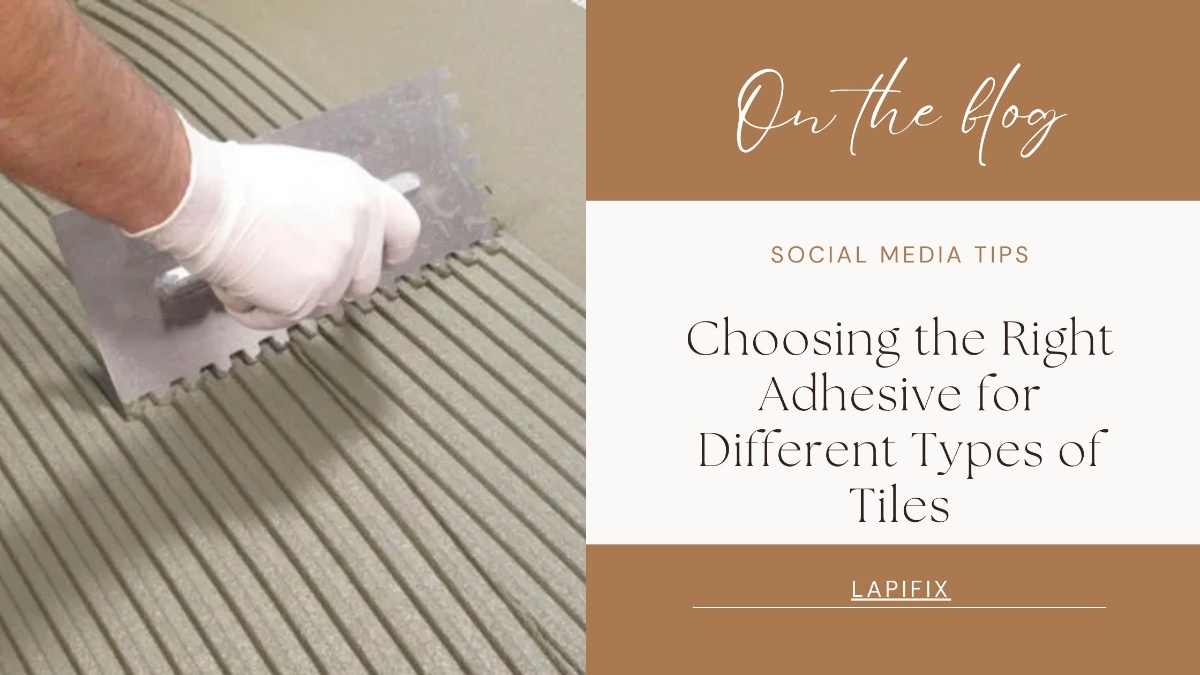


Choosing the right adhesive in tile installation is a very important point in order to ensure a solid bond with long-lasting results. Owing to the unique nature of every material, what needs to apply will be determined by the kind of tile and the environment of installment so that one avoids wasting time and effort and money for the long run.Different tile materials and applications require specific types of adhesives to achieve the best results. This article delves into different tile adhesives, considerations when choosing one, and its best options for various kinds of tiles.
Tile adhesive is a bonding agent for tile fixing. Several adhesives are formulated for various tile materials, surfaces, or specific environmental conditions to offer maximum strength, durability, and water resistance where needed.
Tile adhesives come in three main categories: cement-based, epoxy, and ready-mixed adhesives. Each has unique properties suitable for different tile applications.
There are three general types of tile adhesives:
Cement-based adhesives are among the most commonly used for tile installation. These are powder adhesives that require mixing with water.They are ideal for ceramic, porcelain, and natural stone tiles. These adhesives come in different formulations, including:
Standard Cement Adhesive: Best for dry areas and light-duty applications.
Fast-Setting Cement Adhesive: Reduces drying time, ideal for time-sensitive projects.
Flexible Cement Adhesive: Suitable for areas subject to movement and temperature changes.
Cement-based adhesives are highly versatile, providing strong bonding strength and durability. They are commonly used for floor and wall tiles in both residential and commercial settings.Such adhesives exhibit high strength and are usually used in areas with exposure to moisture.
Epoxy adhesives are resistant to chemicals and water.Epoxy adhesives are high-performance solutions designed for heavy-duty applications. They are best suited for industrial, commercial, and wet environments, offering:
High bonding strength: Ensures tiles remain in place under extreme conditions.
Chemical and water resistance: Ideal for kitchens, bathrooms, and swimming pools.
Durability: Long-lasting and resistant to impact and heavy foot traffic.
Although epoxy adhesives offer superior strength, they require careful mixing and application, making them less ideal for DIY projects.
Ready-mixed adhesives are convenient and easy to use, making them ideal for DIY installations and small projects. They are best suited for light ceramic tiles and indoor use, with benefits such as:
No mixing required: Ready to use straight from the container.
Quick application: Saves time for small-scale projects.
Low VOC options available: Environmentally friendly choices for indoor use.
However, ready-mixed adhesives are not recommended for wet areas or heavy tiles, as they do not provide the same level of bonding strength as cement or epoxy adhesives.
Different tiles require different levels of adhesion strength.Some tile materials require different types of adhesives. Ceramic, porcelain, and the like require different kinds of glue compared to natural stones and glass.
The surface to which the tile is being applied influences adhesive choice.The substrate, or surface upon which the tile is applied, affects the choice of adhesive. An adhesive may be required for installation on drywall that is different from cement board or plywood. Avoidance of troubles like tile settling or weak bonding can be ensured by compatibility with the substrate.
Temperature and humidity, and moisture exposure have a role in adhesive selection. In outdoor or wet locations, a water-resistant adhesive is important; high-heat areas require a heat-resistant adhesive.Areas exposed to water need waterproof adhesives.
Different tile materials require specific types of adhesives for optimal bonding and longevity.
Ceramic tiles are among the most commonly used in homes and commercial spaces. Ceramic tiles are very versatile and may be applied with most adhesives. Cement-based adhesives can be applied well with conventional ceramic tiles, especially where the areas consist of a great deal of moisture. They adhere well with cement-based adhesives, making them suitable for:
Walls and floors in dry areas.
Kitchen backsplashes.
Bathrooms and wet areas with waterproof cement adhesives.
Porcelain is denser and heavier than ceramic. Therefore, a strong adhesive is necessary. Recommended options include:
Polymer-modified cement adhesives: Provides better bonding strength.
Epoxy adhesives: For extreme durability in high-traffic areas.
Flexible adhesives: To accommodate thermal expansion and contraction.
Glass tiles are delicate and require specialized adhesives that prevent cracking and enhance transparency. Clear adhesives are also required in the use of glass tiles so not to cause visibility problems and keep the tile clean. For glass tiles, epoxy adhesives are recommended as they possess the property of being able to withstand exposure and being transparent, ideal for backsplashes and accent walls. Best choices include:
White adhesives: Prevents discoloration and enhances appearance.
Flexible adhesives: Helps prevent cracking due to movement.
Natural stone tiles require adhesives that prevent staining and provide strong bonding. Natural stone tiles are heavy and porous, so they require a premium-quality adhesive. Epoxy adhesives and polymer-modified cement-based adhesives work well, offering the strength needed for heavy stones. Be sure to choose an adhesive that won't discolor light-colored stones like marble.The best options include:
Non-staining adhesives: Prevents discoloration of natural stone.
High-bond strength adhesives: Ensures a secure hold on heavier tiles.
Epoxy-based adhesives: Suitable for high-traffic and wet areas.
Outdoor tiles are exposed to extreme weather conditions, requiring adhesives that resist temperature changes and moisture and UV radiation. Seal yourself with a cement-based adhesive that is designed for outdoor installation that is typically termed flexibleor weather-resistant.
Best options include:
Waterproof cement adhesives: Prevents water penetration and damage.
Frost-resistant adhesives: Suitable for cold climates.
For areas exposed to moisture, it becomes paramount to seal using waterproof adhesives like epoxy or specialized cement-based adhesives. Water cannot penetrate the surface through these adhesives so there won't be chances of mold or mildew due to wet conditions.
For a Fireplace and Stove When placing tiles around a fireplace or behind a stove, high heat exposure is expected. For this purpose, high heat-rated adhesives are to be used, as it would be important for the tiles not to loosen or crack with extreme heat.
Waterproof adhesives: Best for bathrooms, kitchens, and swimming pools.
Heat-resistant adhesives: Essential for fireplaces, outdoor BBQ areas, and saunas.
Small and Medium Tiles: Standard-size tiles can often be applied with common cement-based or organic mastic adhesives, depending on the specific application. Ceramic is also often a good choice for mastic because it is lightweight.
Large Format Tiles: Large tiles are mostly heavier than the standard tiles and require high strength adhesive for avoiding slipping in position and for keeping the tiles as strong as possible. Thicker polymer-modified cement adhesive best suits it, and can take care of extra weight without shifting of wider grout lines.
Follow manufacturer instructions to mix cement-based or epoxy adhesives. Achieving the right consistency is crucial; the mixture should be neither too thick nor too runny. Properly mixed adhesive ensures even application and a strong bond.
Scrabble the adhesive evenly across the substrate using a notched trowel. The size of the notch would vary with the size of the tile. For the larger tiles, they require bigger notches to fix them properly. Even application will avoid gaps and air pockets, which might weaken the bond.
Let it tile onto the adhesive, but press down so it is touching the adhesive. Shake the tile a little to remove any air trapped inside. Use spacers to maintain your grout lines evenly. Allow the adhesive to set as recommended by the manufacturer.
Using an inappropriate adhesive may cause tiles to loosen or stain. Always use an adhesive appropriate for the type of tile material and environmental condition to ensure durability and cleanliness.
Attempting to work on the adhesive too soon can result in poor adhesion. Follow the manufacturer's curing recommendations to allow the adhesive sufficient time to cure fully before introducing additional weight through grouting, for example.
Too much adhesive could leak between the tiles. Too little adhesive weakens the bond. Be constant in applying an amount that suits the tile size and type. Apply evenly without any mishaps on leveling or bonding.
Some tile materials, especially natural stone, may need the sealant reapplied to keep the adhesive fresh and prevent water or stain penetration. Monitor the sealant and renew it as needed to ensure your finished installation.
Inspect the tiles for any movement or exposed edges. Solve problems right away by applying additional adhesive or grouting to prevent further loosening or damage, especially in heavy trafficked or moisture-exposed areas.
The right adhesive can be the making or breaking of tile installation with a secure and durable finish. A lot of people do not realize the requirements of the adhesives depending on the type of tile and environmental and installation conditions. From moisture-resistant adhesives for bathroom use to heat-resistant adhesives for fireplaces, matching the right adhesive with your tile type and environment is the key to a successful installation.
Porcelain tiles require a stronger adhesive than ceramic due to their density. For porcelain, a polymer-modified cement adhesive is usually best, while standard cement adhesive can work well for ceramic.
For outdoor use, choose a cement-based adhesive specifically labeled for outdoor and flexible applications to handle weather conditions and temperature changes.
Yes, epoxy adhesive is often better for glass tiles due to its transparency and strong bonding capabilities, which help prevent visibility issues and ensure long-lasting results.
Curing times vary by adhesive type, but most require at least 24 hours before grouting. Refer to the manufacturer’s instructions for exact curing times.
Natural stone tiles like marble and granite require a high-strength adhesive, such as epoxy or polymer-modified cement-based adhesives, to support their weight and prevent discoloration.
Yes, waterproof cement-based and epoxy adhesives are ideal for wet areas.
Epoxy adhesives provide the highest bonding strength and durability.